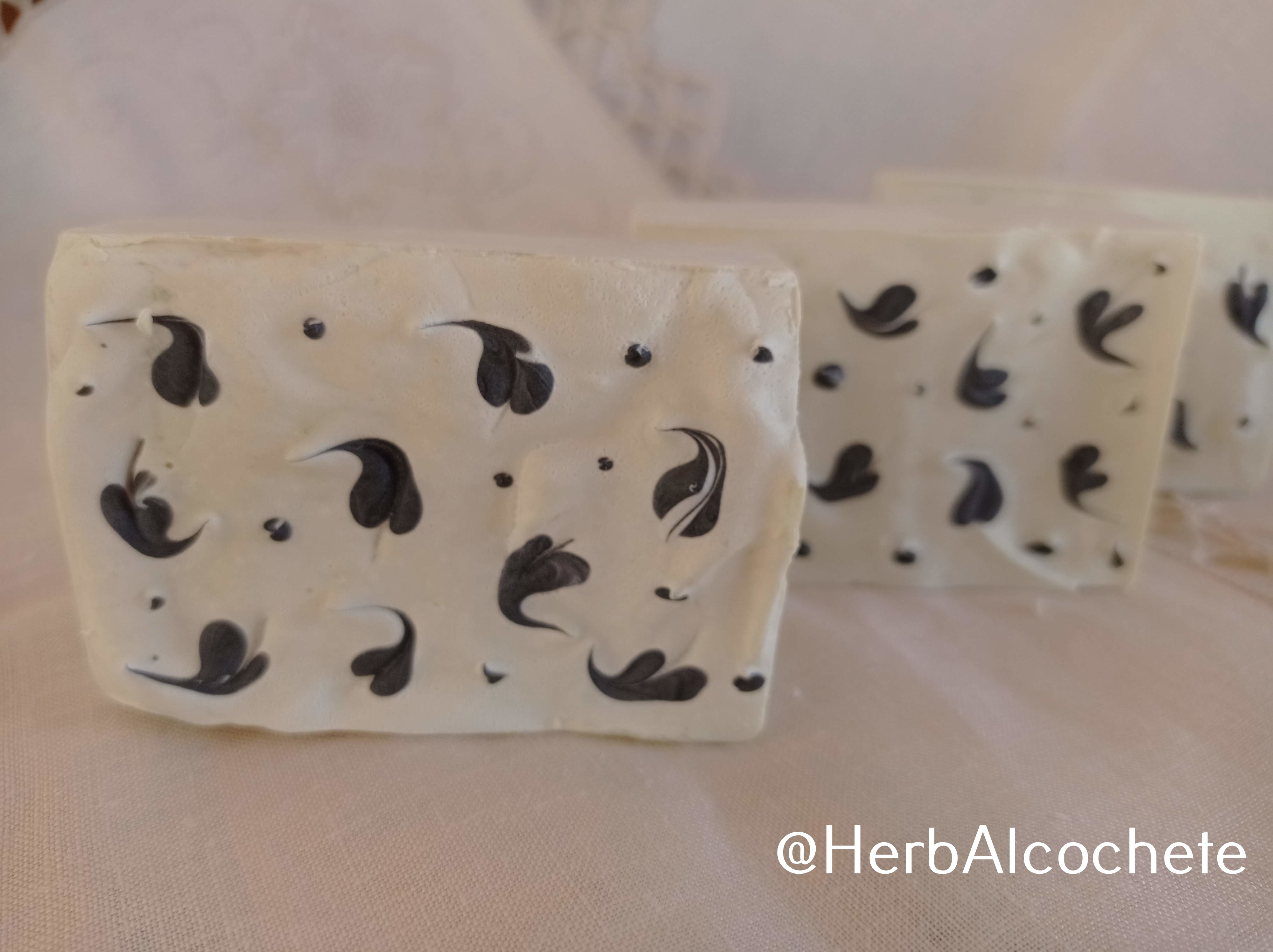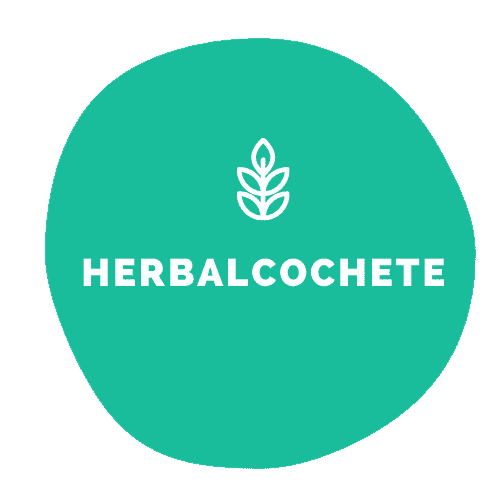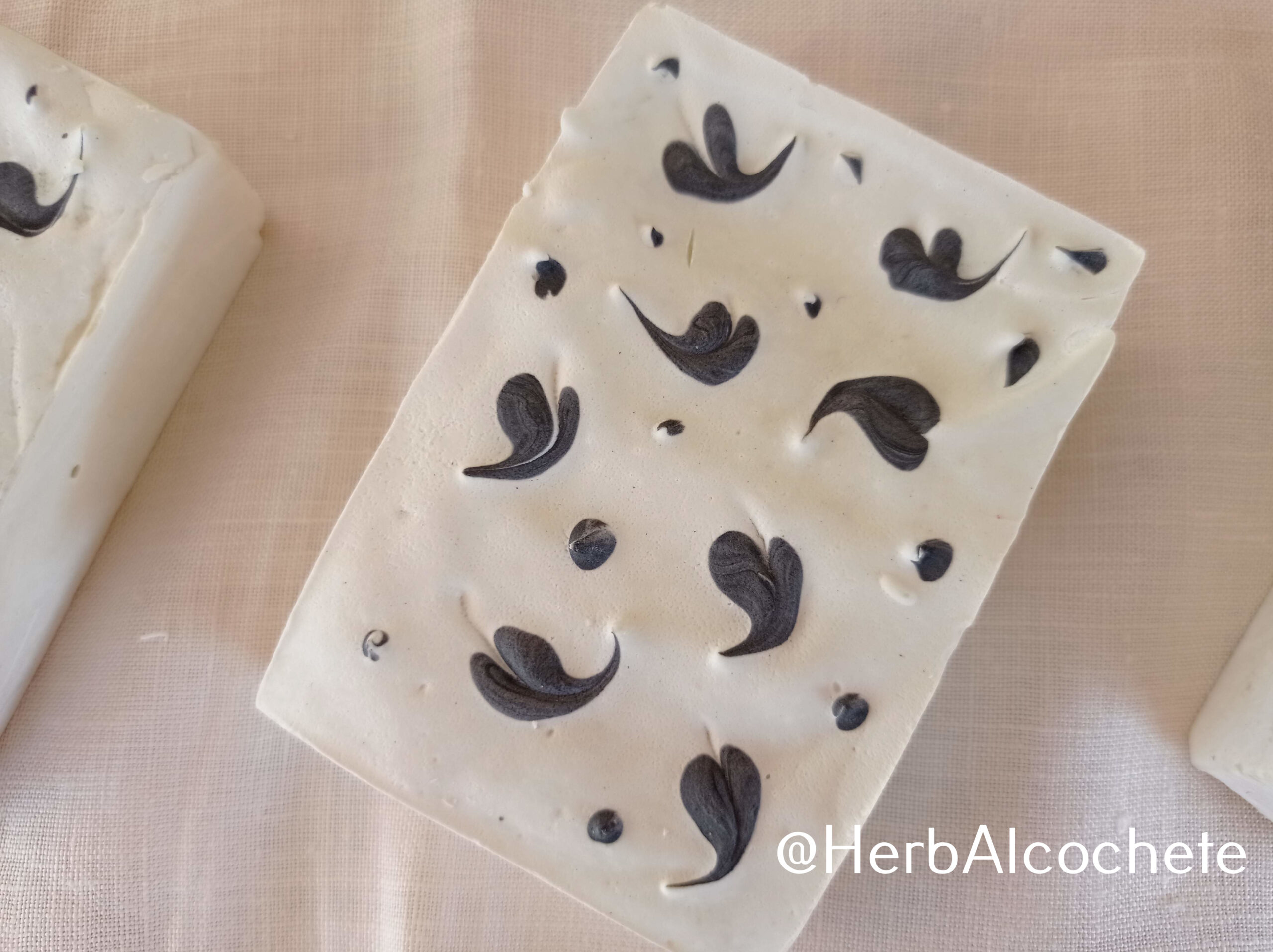Learn how to make a very simple soap design with this olive oil soap recipe. The technique is very simple and yet the effect is beautiful, turning your soaps into professional works of art. Simply great for gifts. Olive oil soap is used to give you time to work this technique using drops of soap, since olive oil soap takes a long time to set.
How Do You Make Simple Soap?
You can make simple soap using 3 ingredients only: lye, water and one oil or fat. These are actually the soap recipes I use to let you know how to make soap at home. And I highly recommend starting with them. Check them out in Soap Recipes for Beginners Category or in How Do You Make Soap For Beginners?
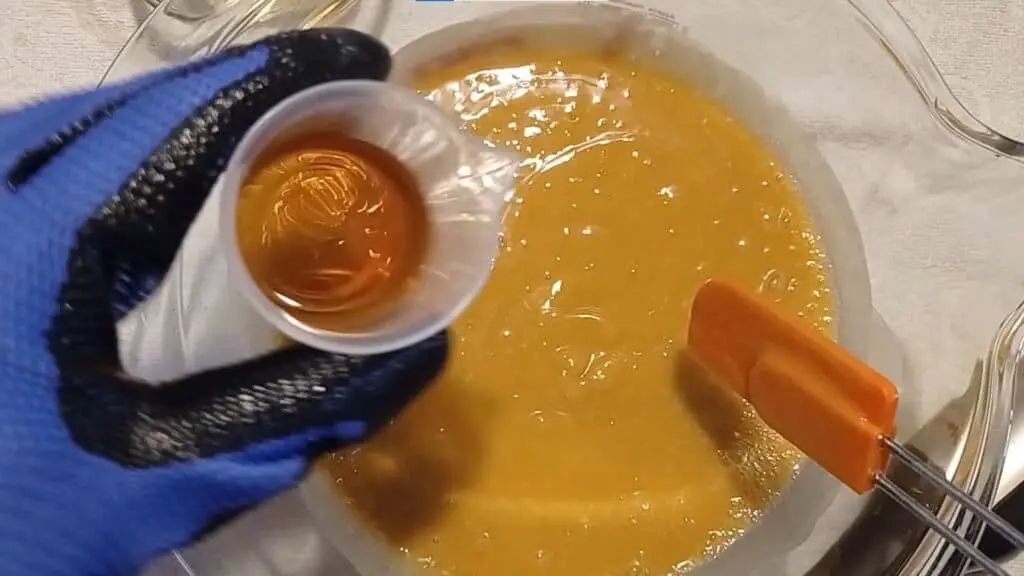
Cold process is the simplest and mostly used technique to make handmade soap. It does require some experience to recognize the various steps: the right time to add ingredients and when to mold the soap. But to make it, you basically only need an immersion blender and some simple kitchen ware. Couldn’t be simpler. Just be very careful with lye. Check out Soap Making Safety Precautions.
In this recipe, I use 100% olive oil. Olive oil is a staple ingredient in Mediterranean countries: cheap, with good quality and very abundant. Being in Portugal, it becomes my favorite soap ingredient and the one I use the most, as it turns my soap cheaper. Would be a crime not to use it widely on my soaps.
As olive oil soap takes a long time to trace, it’s good to make designs, especially when you need you soap batter liquid for them.
What Does Olive Oil Soap Smell Like?
Olive oil soap has a very delicate, mild and pleasant scent of what I can only call as olive oil soap salts. At the beggining of curing, the smell reminds you of baked olive oil, but then it turns into truly unscented soap. No roses, or lavender aroma, just plain delicate fragrant soap. You really have to use one to know exactly what I am talking about.
I’ve decided to make this soap unscented. I’ve added oatmeal in this recipe and I wanted to find out how olive oil soap salts and oatmeal would smell like. The smell is really of just soap salts as in a pure olive oil soap.
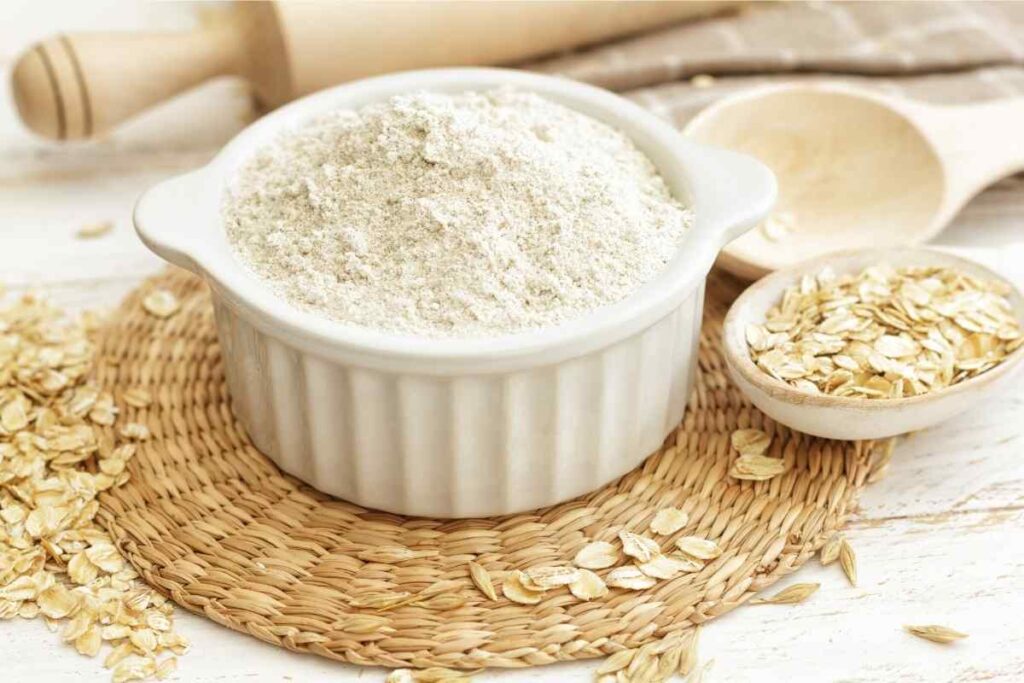
Curing with other fragrant soaps, this soap literally captured the other scents around! It has a faint, mild smell of roses when you approach it from your nose, without having used any essential or fragrance oil in it! My only explanation is that oatmeal is a “scent fixer”, and easily absorbs and “fixes” other scents.
I am sure that when I start using it to wash this smell with be gone, but I will tell you later on how the soap scent resulted – the soap is still curing and it needs a couple of months before it’s good to use. It’s the only drawback of olive oil soaps – the long time to cure.
You may add an essential oil to give some scent, like lavender or peppermint, but… just give it a try at uncented soap.
Using Charcoal as a Natural Black Colorant
Activated charcoal is a black, fine powder sometimes used to help treat a drug overdose or a poisoning. In cosmetics, it helps to trap and clear toxins, oil and dirt from your skin, due to its absorbing properties. It’s commonly used in csoaps for oily skin and face masks. Even in toothpastes!

It is a natural mineral, making it a natural alternative to black synthetic dyes. Depending on the amount you use, your soap can get a light blue-grey shade, a grey, or a black color.
In this recipe, I’ve used around 1/2 of a teaspoon in 2-3 tablespoons of soap to make a strong black color to contrast with the light cream base. I’ve actually eyeballed this, and you probably don’t need so much charcoal.
A Simple Soap Design
You won’t believe how simple this soap design is! It consists of using drops of soap on top of your soap surface, and then drawing effects with a wooden stick. Unlike most soap designs, done in loaf soap molds, this one is good for rectangular individual silicone soap molds. You can decorate a whole soap surface in a plain rectangular soap.
Your soap needs to reach light to medium trace. With plain olive oil and no accelerating addictives, it might take 10 to 15 minutes of stick blending. At first attempt, I would advise to stick blend only for 10 minutes, since the soap batter needs to be liquid. Just make sure there are no separated, floating oils.
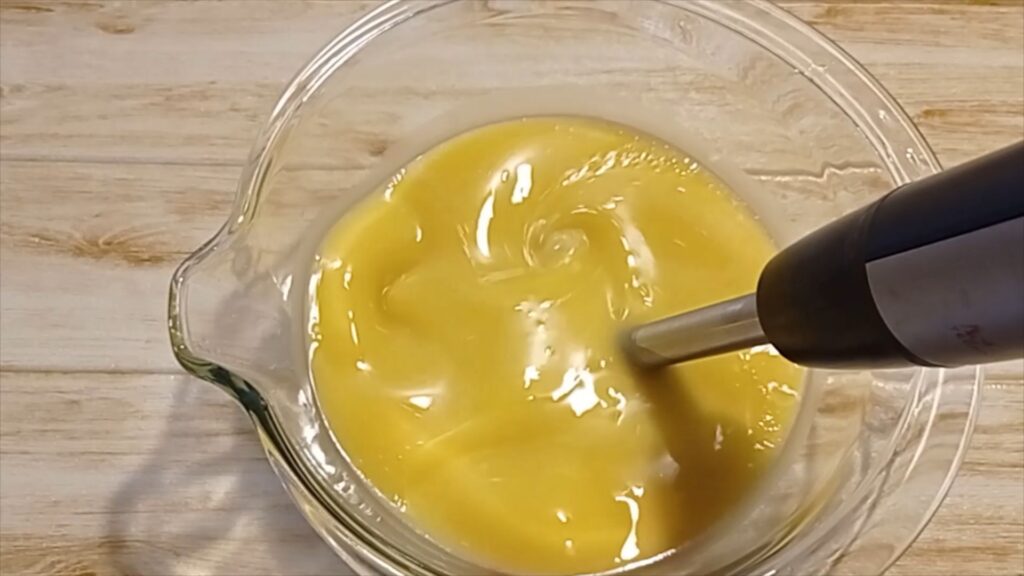
At this moment, collect 2 or 3 tablespoons of soap batter into a small bowl and add 1/4 teaspoon of activated charcoal. To avoid lumps, mix the activated charcoal with a bit of oil in order to have a “liquid” colorant. However, I have mixed this directly with the soap batter using a spatula. I had to mix it very well, but there were no visible lumps of colorant. Or, being everything black, you can’t spot them.
Pour the rest of the soap into your rectangular silicone soap molds.
Small Leaves
Now it comes the art! Using a small spoon or a wooden stick (like the ones you use for kabobs), place small drops of black soap batter into the soap surface. Place the pointy tip of your wooden stick nearby each black drop and draw a semi circle. Clean the wooden stick each time you do this. Check out how to do it in this video. I have recorded my own art, but my hand covers the entire process…
This way you will be making small cute leaves all over your soap surface! Add some small drops between the “leaves” or you can leave it as is.
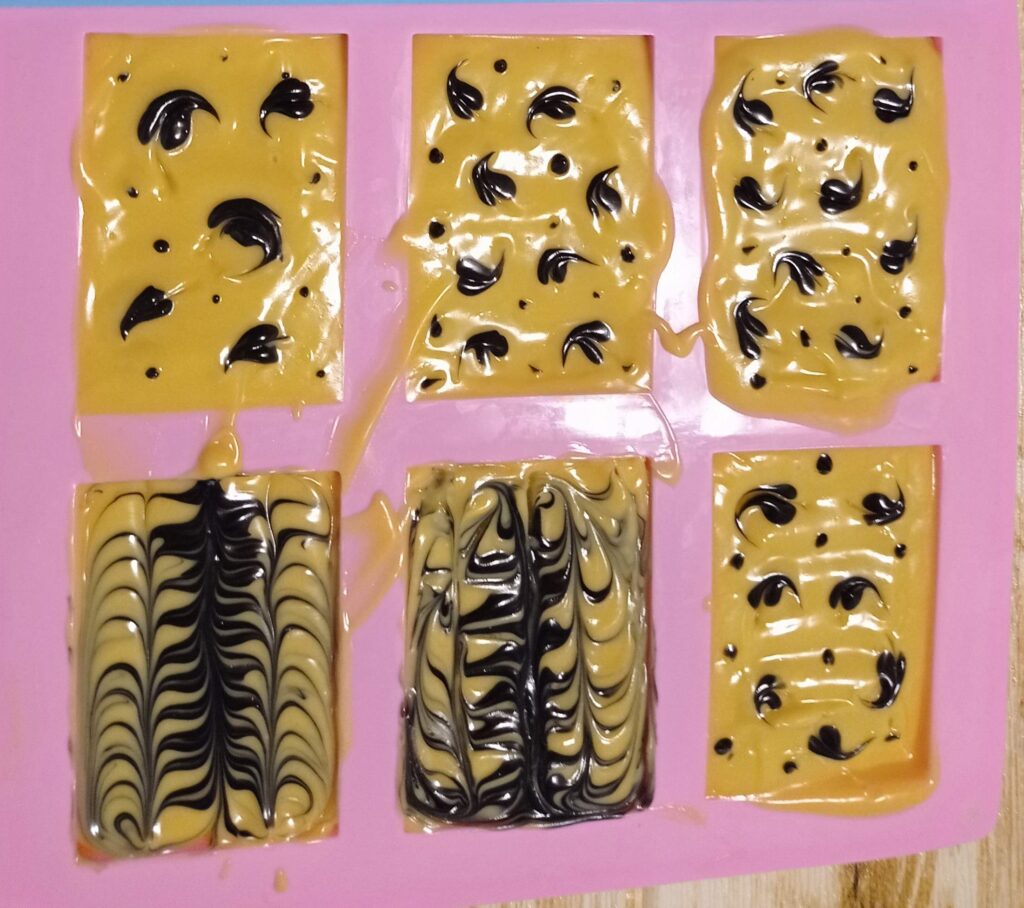

Swirls
Another very simple design you can make on individual soaps are swirls. First, pour a line of black soap batter over the white one, and draw various “S” with the wooden stick. Finish the design by crossing the “S” with a couple of line back and forth.
I’ve ended up using texture as well, as the soap batter was setting into a paste consistency, to make some pretty reliefs.

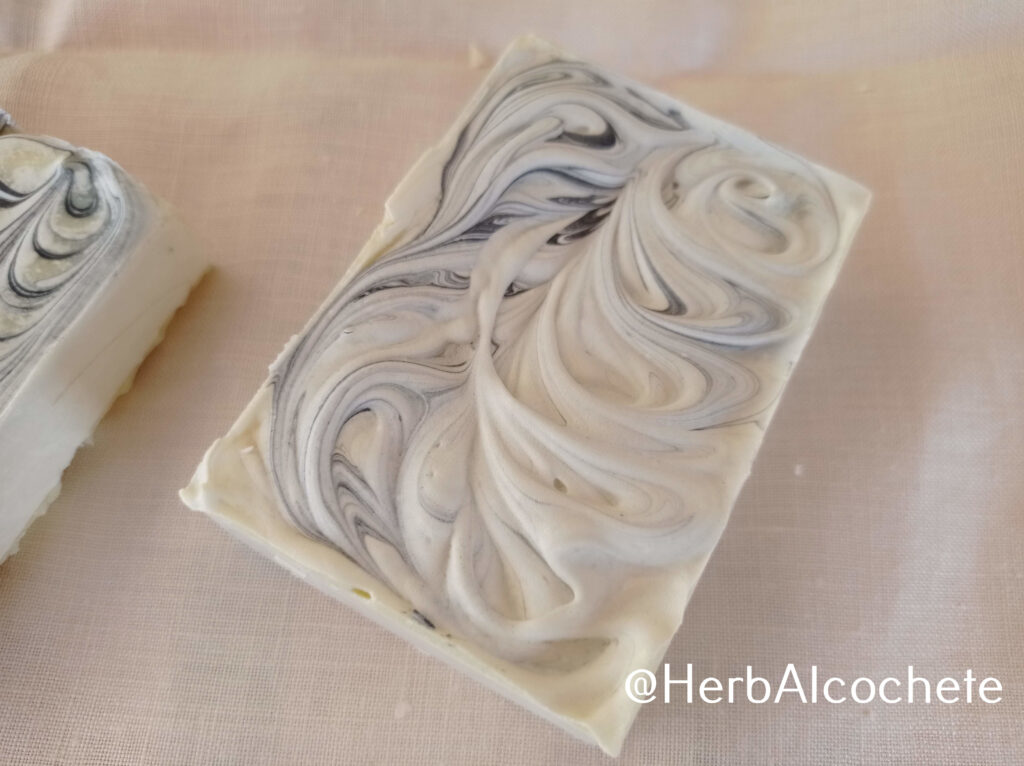

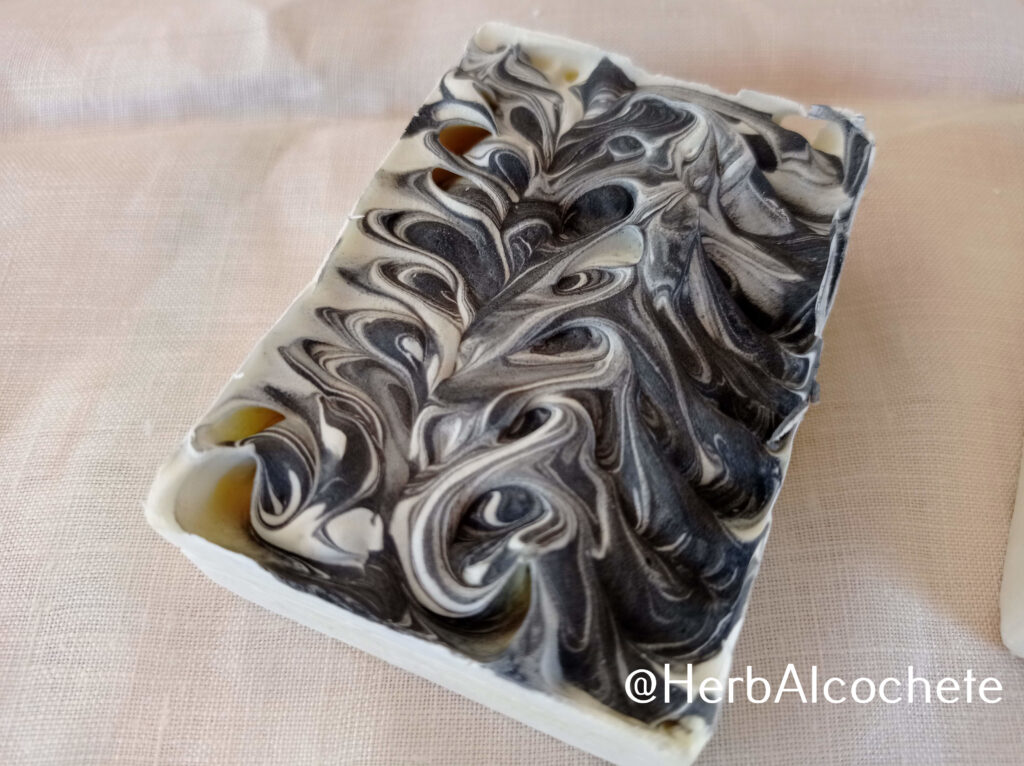
Find Where To Buy Handmade Soaps With Designs
Still not inspired to make your own soap at home? But you do wish to use or give it a try at this beautiful handmade soaps with pretty designs? You can find a few options online to buy handmade soap below:
- Natural Vegan Handmade Design Soap (Etsy)
- Black Raspberry Vanilla Design Soap (Etsy)
- Natural Handmade Design Soap (Etsy)
- Etsy Lavender Layered Soap (Etsy)Natural Handmade Design Soap (Etsy)
How To Use This Soap
In the shower or bath, wet your hands and rub your soap in them to create a lather. Wash your hands first, then repeat the process and apply soap to your whole body using the soap directly and your hands. You may also wash your face with it. Rinse hands and body abundantly. Also wash your soap from lather before placing it in your soap dish or bag saver.
Washcloths and sponges should be avoided. Avoid washing your intimate zone and your hair, soap pH in not adequate for those parts of your body. Avoid eye contact with soap to prevent stinging. Make a patch test before using your soap. Stop using your soap if you feel any immediate adverse reaction in your skin (red skin, rashes, itching).
To take best advantage of your handmade soap (made by yourself or store-bougth), read How Do You Use Handmade Soap?
Related Posts
Ingredients and Recipes
- Vegetable oils: Oil Properties For Soap Making
- Essential oils: Best Essential Oils for Soap Making
- Colorants: How To Color Your Soap With Kitchen Ingredients
- Beginner Recipes: Soap Recipes for Beginners
- Cold Process Soap Recipes: Free Cold Process Soap Recipes
Soap Making Techniques and Troubleshooting
- Cold Process Tutorial Guide: Learn To Make Cold Process Soap?
- Soap Making Methods: How To Make Soap At Home
- Soap Making Trace: Know Everything About Trace in Soap Making
- Soap Acceleration: Causes, How To Avoid It Or How To Fix It
- Soda Ash In Soap: What It Is, How to Remove It
Watch This Video About Safety
Cold Process Soap Making Tutorial Video
Cold Process Soap Making Lessons
The tutorials in this blog are a great – and free! – help to start with cold process soap making. Practice is the next step to harness the art of making soaps at home. However, I understand if you prefer to have some formal lessons, where you will feel more supported with the steps. Feel free to join these courses at Udemy.
Equipment
- Wooden Stick
Ingredients
Lye Water
- 267 g distilled water
- 114 g lye (100% sodium hydroxide)
- 2 tsp fine salt / sodium lactate
Oils/Fat
- 900 g extra virgin olive oil
Add After Trace
- 15 drops grapefruit seed extract (GSE) (anti-oxidant)
- 14 g colloidal oat powder
- 0,25 tsp activated charcoal
Instructions
Get Ready!
- Wear goggles and gloves! Look at “Safety Precautions” in the video above or in Soap Making Safety Precautions
- Watch the video above about "Cold Process Soap Making Tutorial" or read the post Learn To Make Cold Process Soap for instructions on cold process soap making before starting. These are generic but important steps for all recipes.

- Assemble everything: ingredients, equipment, safety equipment. Prepare your workstations. Measure all the ingredients. Don’t start the recipe without having everything ready!
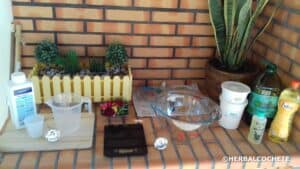
Preparing the colorant
- After measuring your oils, remove 1 tbsp of liquid oil and mix it well with the activated charcoal to avoid clumps.
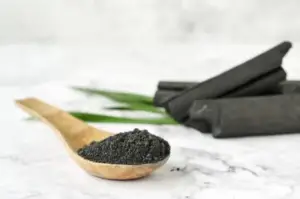
Make the Lye Water
- Make the lye solution according to How To Make Lye Water. Add fine salt or sodium lactate to help harden and set the soap. Mix it until the vapors start to dissipate.

Make the Soap Batter
- Use as target temperature room temperature (25ºC) for the oil-solution mixture. This will help slow down trace. Lye can be hotter than the olive oil, but the lye and oil should not have a difference of more than 10º between them.
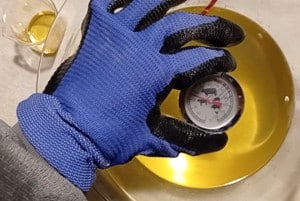
- Mix oil and lye with the immersion blender.
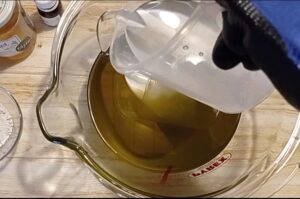
- Reach trace with the immersion blender. Stck blend for around 10 minutes to reach light trace.
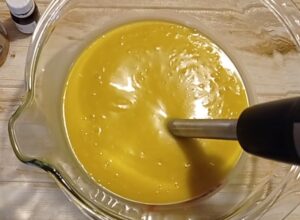
After Trace Ingredients
- Add the extract and oatmeal after tracing. Mix with a spoon or spatula. Just use the stick blender if you are finding lumps.
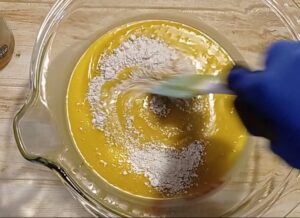
Molding
- Retrieve 2 tbsp of soap batter aside to a small bowl (this can be eye balled) and add the activated charcoal. Mix well until you have a black soap batter.
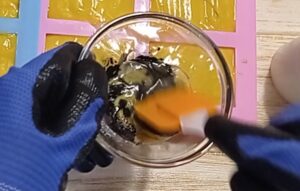
- Pour the dough in the molds.

Making Small Leaves
- Using a wooden stick or spoon, drop small drops of black soap over the creamy soap tops. Then, using the wooden stick sharp point, draw a semi circle, "cutting" the black drop of soap. Make as much leaves as you want.
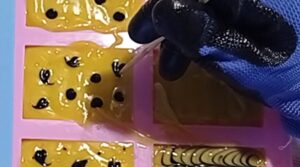
Making Swirls
- This technique is one of the easiest to make swirls on soap. Draw a line of black soap in the middle of the soap surface, along the soap length. If the soap is too thick to be poured, use a spoon. Then, using the wooden stick, draw big slim "S" along the soap. Finish with lines along the length of the soap.
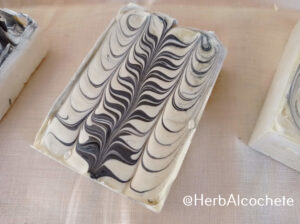
- I have taken advantage of the soap batter getting pasty and also made some textures using the wooden stick. Just draw circles up and down the soap, bringing the creamy soap batter upwards.
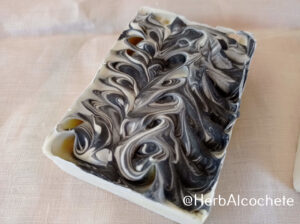
Curing
- Sprinkle the soap with alcohol at the end to avoid soda ash. Letting the soap set for 3-4 days also helps.
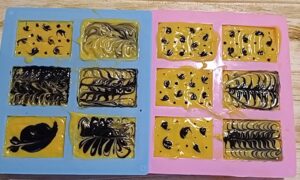
- Learn how to clean all equipment with How to Clean Soap Making Equipment.
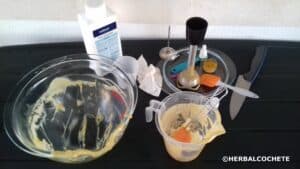
- Unmold and let the bars cure for 8 weeks minimum, or more. See How To Cure Soap and How Do You Store Homemade Soap? Enjoy your soaps!!
